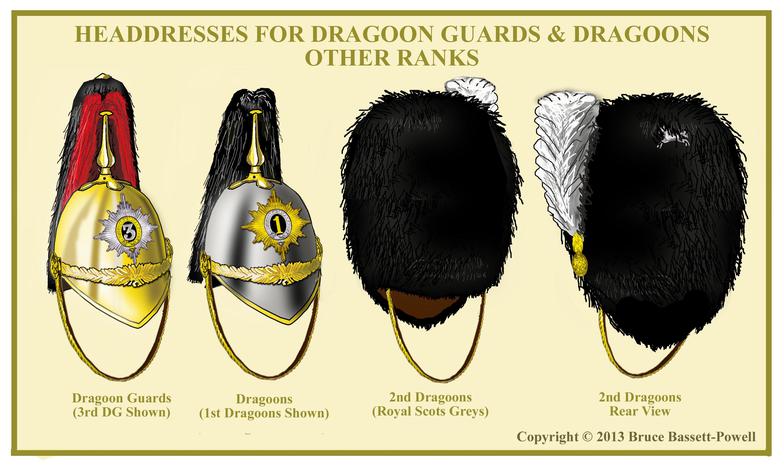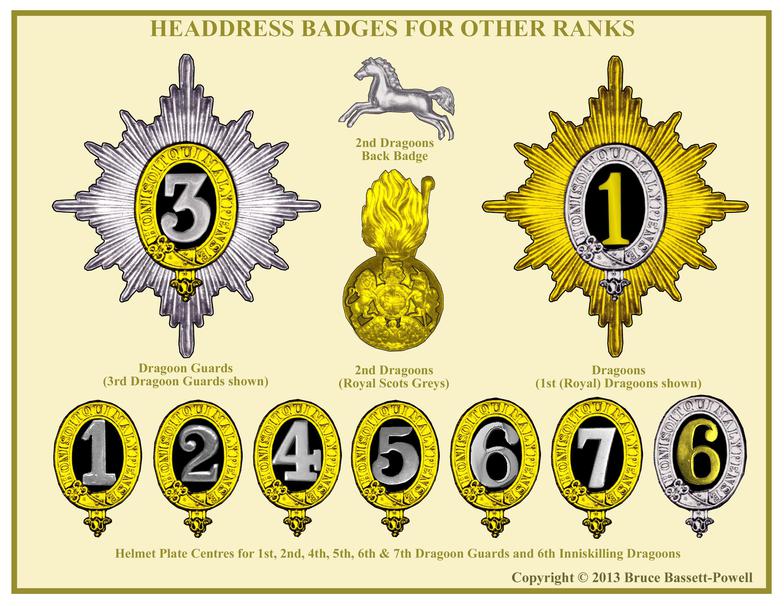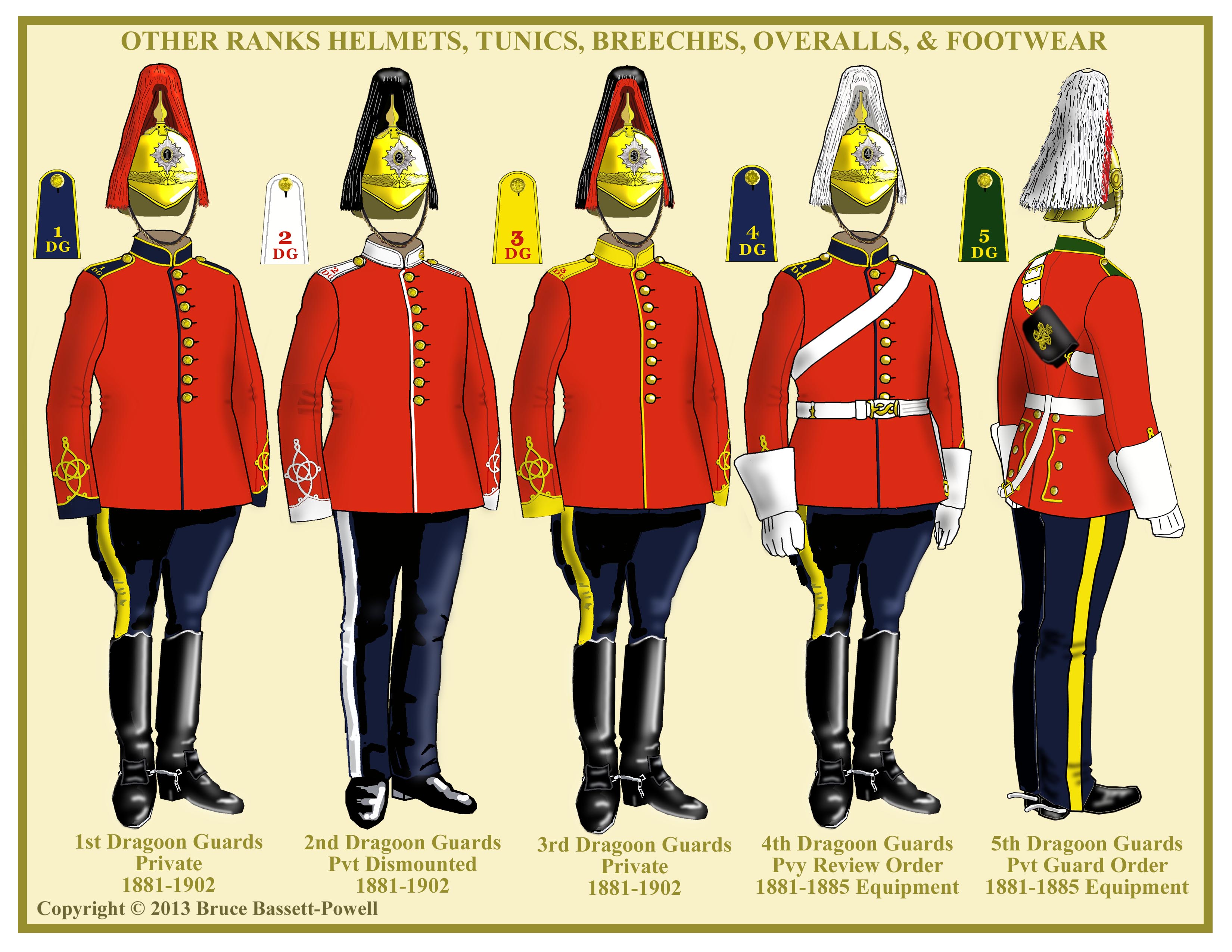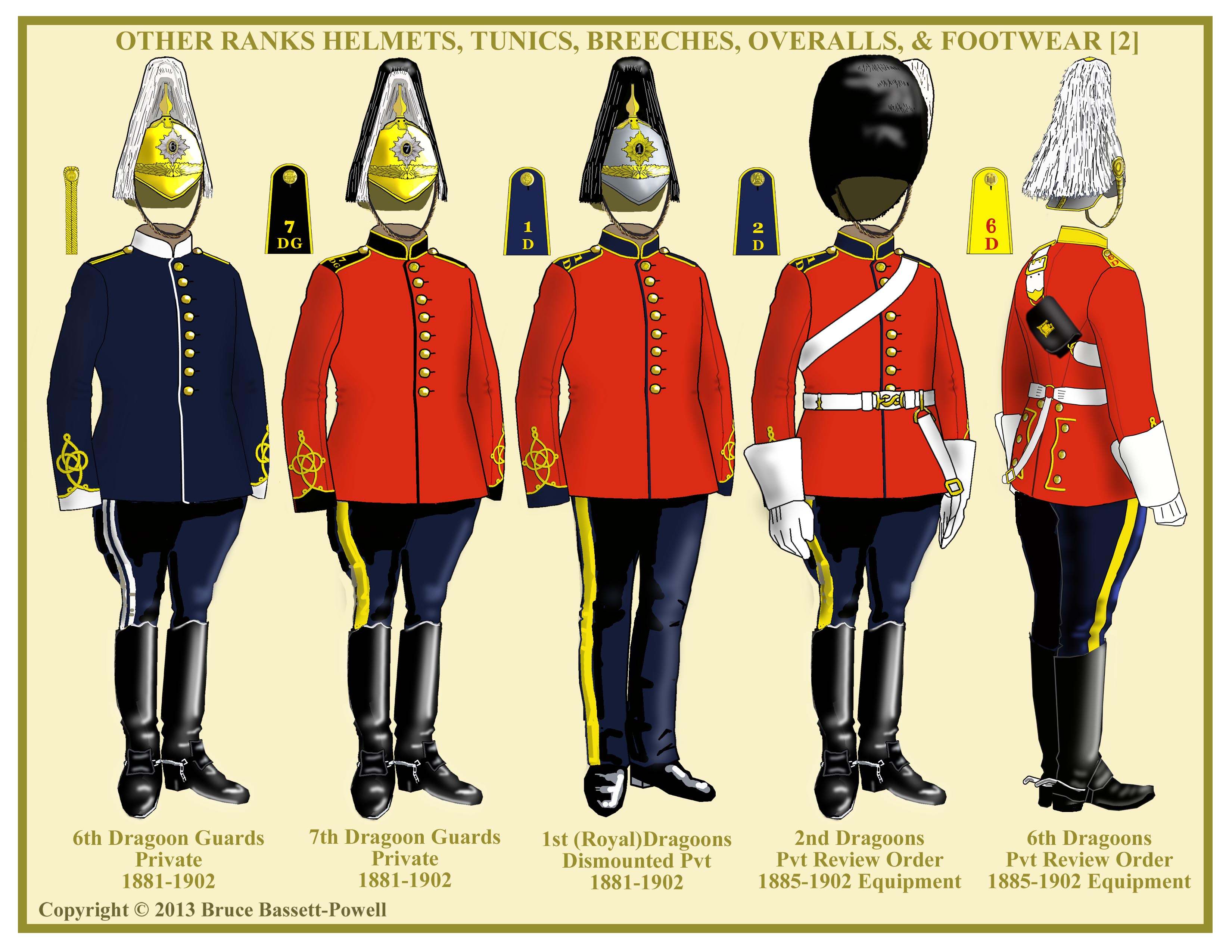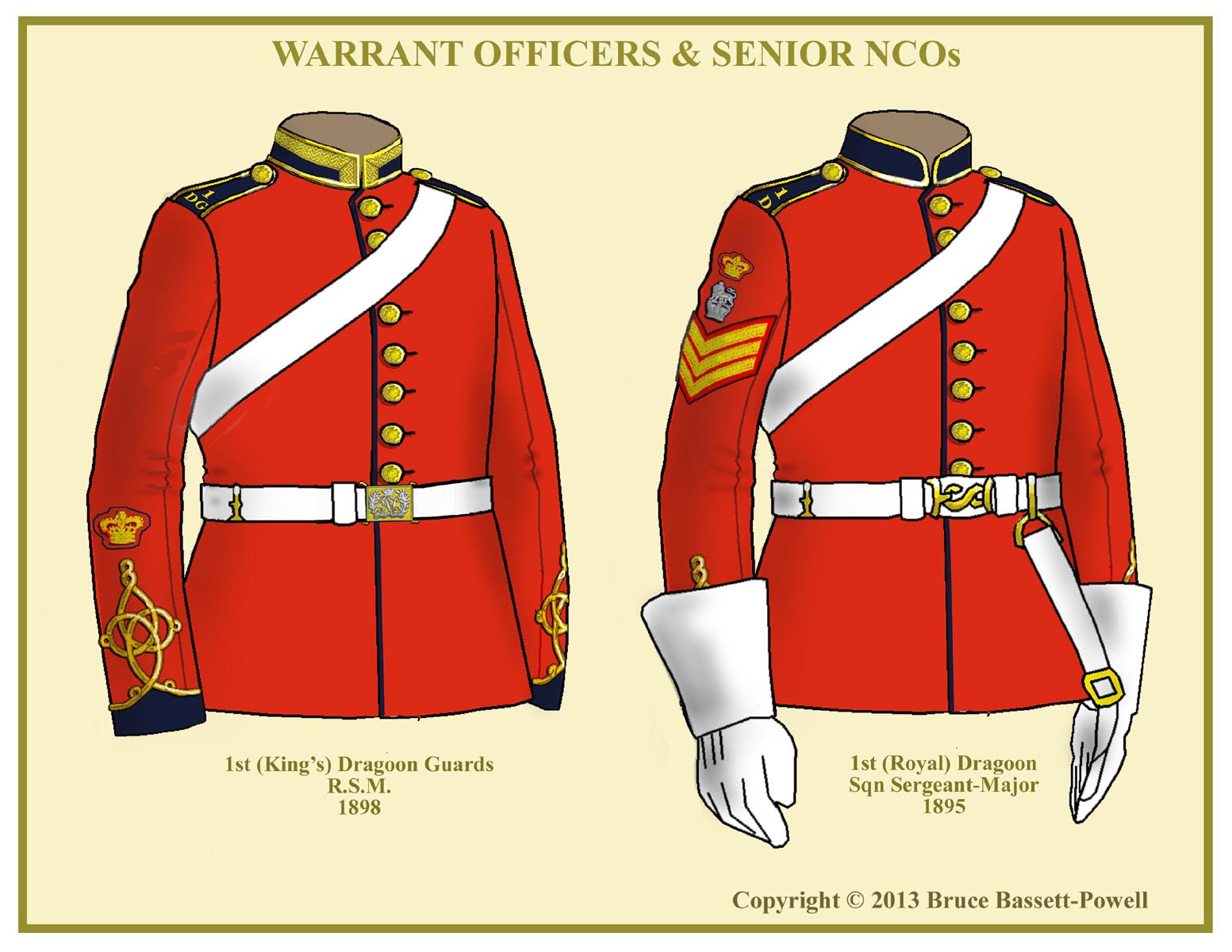PART II
OTHER RANKS
The Childers reforms of April 1881 included a major overhaul of the rank classifications for the rank and file. The creation of Warrant Officers comprised (for cavalry of the line) Regimental Sergeants Major to which were added Regimental Quartermaster-Sergeants, 1st Class staff Sergeants and Bandmasters later that year. This reform also standardized and simplified the badges of rank worn by all ranks in all branches of the army. For the cavalry of the line, the two decades that followed were marked by organizational changes. The establishment of the regiments was increased in April 1890 from 488 men and 300 horses to just over 700 men and 450 horses. In December, the structure was also changed from two squadrons with 3 troops each to four squadrons of two troops with the side effect that Troop Sergeants Major became Squadron Sergeants Major, now of course reduced to four per regiment.
During this period, all Dragoon Guards regiments spent some time stationed overseas, mostly in India. The 6th Inniskilling Dragoons were sent to India in 1897 but neither the Royal Dragoons nor the Royal Scots Greys were sent to India. Most of the regiments saw campaigning in Egypt and the Sudan either as regiments, detachments or members of the Camel Corps. All ten regiments served in the Boer War 1899-1902.
With regards to dress, the Dragoon Guards and Dragoons wore much the same uniform as that adopted in 1874. Apart from minor changes in details, equipment and service dress it remained that way until the end of the century.
HEADDRESS
The helmet worn by nine of the ten regiments were essentially the same as that worn by the officers and differed only in material and minor details. The shell for the Dragoon Guards regiments was brass as were the fittings. Comparison between the men’s version and officers that exist today shows the shell to be slightly more rounded and the pointed peak shallower for the other ranks. The spike, four-leaf base, rear seam decoration, front band, rosettes and curb chain were identical in style to the officers. The spike for all regiments was the fluted kind without the sphere as worn by officers of the 2nd DG, 1st & 6th Dragoons*. The two Dragoon regiments had white metal shells but otherwise the same as for Dragoon Guards. The plumes were the same as for officers but volume of horsehair used was somewhat less. They were removed from the spike for home service use on manoeuvres and exercises. The bearskin for the 2nd Dragoons (Royal Scots Greys) was shorter than for the officers and made of hair from the male bear rather than the female. The white plume was somewhat shorter and worn on the left side. A white metal Hanoverian leaping horse was worn on the upper rear of the bearskin.
The wearing of special pattern helmets by warrant officers and senior NCOs is difficult to determine. Photographic evidence is scarce but it seems there is a photo of the RSM of the 4th Dragoon Guards in 1881 wearing an officer’s pattern helmet. There is definitely a photo of the RSM of the same regiment dressed almost entirely as an officer in the year 1902 which suggests that this was a regimental matter. Most photos show RSMs wearing the same headdress as the rest of the regiment. Since warrant rank was only created in 1881, it may be that the acquisition of officers’ helmets and other distinctions by warrant officers was a growing trend as the years progressed. After 1902 most warrant officers of Dragoon Guards and Dragoons were wearing officer’s pattern helmets.
* An other ranks helmet of the Royal Dragoons with a sphere between the spike and base can be seen at the Household Cavalry museum in Windsor. As so often in the British Army .... anomalies abound.
HEAVY CAVALRY UNIFORMS, ARMS & EQUIPMENT - DRAGOON GUARDS & DRAGOONS
HEADDRESS BADGES
The Helmet was fitted with a twelve pointed rayed star in white metal for Dragoon Guards and brass for Dragoons. An oval garter (brass for DG, white metal for D) bearing the motto “HONI SOIT QUI MAL Y PENSE” was in the centre and within that was the regimental numeral on a black leather backing, again in opposing metals. The style of numeral was never described, but those shown in the illustration above appear to be the norm. Some examples of the 3rd Dragoon Guards “3” with a rounded instead of flat top have been seen. The Royal Scots Greys had a flaming grenade in brass with the Royal Arms and St. Andrew with Saltire on the ball which included the plume holder. The white metal Horse of Hanover was fitted on the upper rear of the bearskin. This badge could often be less than apparent as it was buried behind the fur.
UNIFORMS
Other ranks of Dragoon Guards and Dragoons (except the 6th DG) had worn scarlet tunics instead of brick red since 1870. After 1881 there was little change except that the collars became more squared and slightly deeper after 1895 alongside those of the officers. The tunic facings were the same as for officers and the 1st, 3rd, 4th, 5th and 7th Dragoon Guards collars, cuffs, shoulder straps and tunic edging were velvet while the remainder were cloth. The tunic had eight buttons down the front, two at the rear waist and three on each skirt flap. A smaller button was worn at the top of each shoulder strap. The collar and shoulder straps were edged in ¼ inch yellow lace as was an Austrian knot on each cuff. The design of this knot included five extra small ‘curls’ which distinguished them from Austrian knots worn in other regiments. The scalloped flaps on the tunic skirts were also edged in yellow lace. The collar, shoulder strap, cuff and tunic skirt lace in the 2nd Dragoon Guards was white. The skirts of all cavalry regiments were somewhat shorter than those in the other (dismounted) units. The regimental designation was worn on the shoulder straps in yellow cloth for most regiments except the 2nd and 3rd Dragoon Guards and the 6th Dragoons in which it was red. It comprised the number over the letters ‘DG or ‘D’.
The The 6th Dragoon Guards tunic was, of course, blue with white cloth facings. The main differences from the other regiments were as follows:- Instead of shoulder straps, the 6th DG wore yellow cords (without numerals), there was no yellow edging to the collar and the yellow Austrian knots had small ‘curls’ on the lower parts only. The skirt flaps were edged the same as for other regiments.
The dark blue overalls and pantaloons were the same style as for officers with yellow stripes for all regiments except the 2nd Dragoon Guards with a single white stripe and the 6th Dragoon Guards with double white stripes. Black ‘Butcher’ boots with a V notch at the top were worn for mounted duties and wellington boots for dismounted. Spurs were steel swan-neck.
Army clothing regulations allowed for a “First class staff tunic” for Warrant officers and senior NCOs. Although this tunic, shown by its cost to be of better quality than other ranks, was worn by Warrant ranks in the Dragoon Guards and Dragoons, it does not appear to have born the embellishments like extra gold lace that other branches of the army enjoyed. Even those ranks in hussar regiments had gold lace frogging and cuff lace. However, by the end of the century it does appear that the Warrant officers and SNCOs in some regiments were wearing a visibly more ornate uniform. The RSM, SNCOs and the band of the 4th (Royal Irish) Dragoon Guards seem to have had gold laced tunics since about 1885. The RSM and SNCOs of the Royal Dragoons had gold lace after 1893 while the 1st (Kings) Dragoon Guards RSM had officers’ collar lace on his tunic in 1898 and an officers waist plate on his belt and apparently, like the officers had his sword-slings under the tunic skirts. After 1902 the RSMs of the heavy cavalry began to wear uniforms more closely like the officers.
ORDERS OF DRESS
In mounted review order, NCOs and privates (the designation “Trooper” for cavalry privates was not used at this time) wore their full dress tunic, pantaloons and knee boots along with shoulder belt, pouch, waist belt and gauntlets. (see equipment in section II/4). Dismounted review order was the same with overalls instead of pantaloons. For mounted guard duty from 1881-1897 the carbine was carried with the butt resting on the right thigh and the soldier gripping its stock. After that along with the arrival of the Lee-Metford carbine, only swords were carried on mounted guard duty. For dismounted guards, quarter-guards the carbine was also carried before 1897. When turned out, the guard carried their carbines at the "Advance" (which for those of us who carried the L1A1 on parade (!!) was at the "Shoulder Arms"). When marching on and off off, they carried carbines at the trail.



